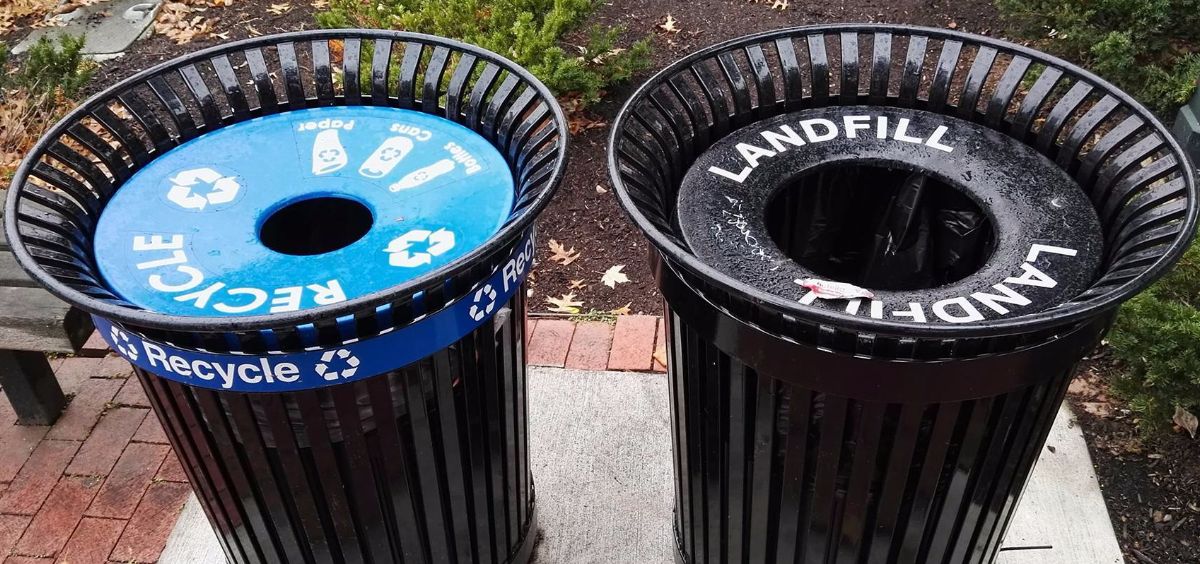
OU Recycles 58% of Trash – Goal was 80%
By: Lauren Ramoser
Posted on:
The USA is the world’s leading trash nation. An average American produces 4.4 lbs of garbage every single day. According to a study by the United States Environmental Protection Agency the global average is only 2.6 lbs. Statistics from the same study show that the recycling rate has increased significantly within the last 50 years, but data does not show that garbage production has increased as well.
The job of the Ohio University Recycling Center on The Ridges starts when someone on campus makes the decision to throw trash into one of the blue recycling bins. But not all of it makes its way up the hill to The Ridges. Household waste, such as cans, bottles and papers get picked up by the AHRC and transported to the Athens Hocking Recycling Center (AHRC) on Poston Road in The Plains. Electronical trash, books, medical supplies and other bigger items go to the Campus Recycling and Zero Waste facility on The Ridges.
OU’s Recycling Plan
But waste management as we know it hasn’t always been like it is now, according to Andrew Ladd, Campus Recycling and Zero Waste Manager.
“As we work with AHRC, my crew can focus on increasing composting and event management and a lot of stuff we couldn’t do when we spent all our time sorting paper back in 2013,” Ladd said.
Ladd walks through the old brick building that houses the recycling center, passing a variety of containers, boxes and piles of electronics.
“We never deal with paper or plastic up here, but we take, for example, books,” Ladd said. “Because glue and binding are a fairly significant contaminant in the paper recycling stream.”
Reused and recycled
As for many other goods, they try to work with companies to get reusable goods like wires or electronics back on the market.
The current recycling goal of OU is set at an 80 percent recycling rate. This can be achieved through composting, donating, recycling or reusing.
“The last fiscal year, 2016, we were functioning at a 58 percent recovery rate. The sustainability plan was adopted by OU president in 2011. 80 percent should have been achieved by 2016. Now it is extended to 2021.”
-Andrew Ladd
The original idea of OU’s sustainability plan was to achieve an 80 percent recycling rate by 2016. The goal has simply not been accomplished. The consequence of this is the renewed plan got extended to 2021.
OU couldn’t achieve its own goal. But according to Ladd, the recycling rate is still increasing. One reason the data doesn’t look as good as it is: OU switched from coal to natural gas.
Some numbers lie
“Coal creates coal ash, but it can be mixed with salt and used on roads for ice mediation”, Ladd says. “But now we stopped producing these hundreds of tons of coal ash, which is great, but from just trying to hit the percentage it looks like the numbers get down.”
More of the coal ash got recycled as it was reusable, but now these high numbers are missing. OU improved with switching from coal to gas, but the big percentage of recyclable coal is not in the recycling statistics anymore.
One big part of the problem is food waste. In 2016, 1.8-million-pounds of food waste were composted. That includes not only food but also biological waste.
A long way to go
“But there is still more than one million pounds of food waste, which is insane”, says Ladd. One million pounds is equal to the weight of a Boeing 747 jumbo jet.
Recently OU introduced a solution to minimize food trash. They decided to take trays out of the dining halls. It is still all-you-can-eat, but as students can only get as much as they can carry, food trash has been reduced since the beginning of this fall semester.
“We are hoping for getting 10 percent less, what would be 100.000-lbs less food wasted every year.”
-Andrew Ladd
That would be as much weight as 30 regular cars.
According to AHRC manager Bruce Underwood, the center is the only recycling service in the area right now. It is a non-profit organization, that has contracts with OU as well as the City of Athens. Within the city limits alone, 20 tons of trash was collected every day by AHRC last year.
Mining landfills
Underwood said that up to 75 percent of the trash that is brought to landfills could be recycled, referring to numbers of national statistics.
Underwood also said that the number of participating households has increased after switching to single-stream collection. Single-stream recycling makes it easy for people to recycle.
Instead of a mixed-stream system, where people have to divide trash at home into different materials, organizations like AHRC do this work after picking up the recycling bins. This takes a lot of effort to divide the variety of materials, but that is a small problem compared to the amount of trash filling up landfills.
Change is needed
“It gets buried in the ground and, at least theoretically, it stays there indefinitely. And my personal belief is, one day we will go back and mine our own landfills and pull out valuable materials”, Ladd says. But he is hopeful.
“Landfill-garbage from OU has gone down by 16 percent. This is our biggest success in the last four years. We are talking about 1.000 tons,” he said.
The decision between a recycling or a landfill container takes the same effort for people, but it makes a difference for our environment and our future.

